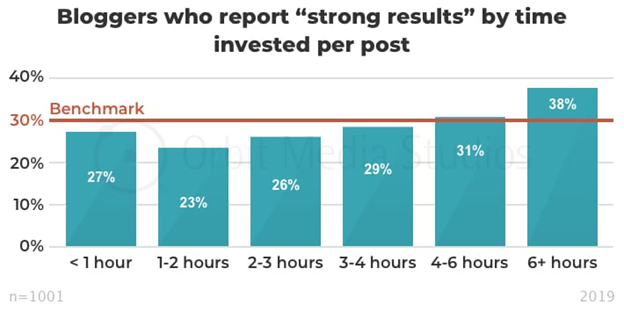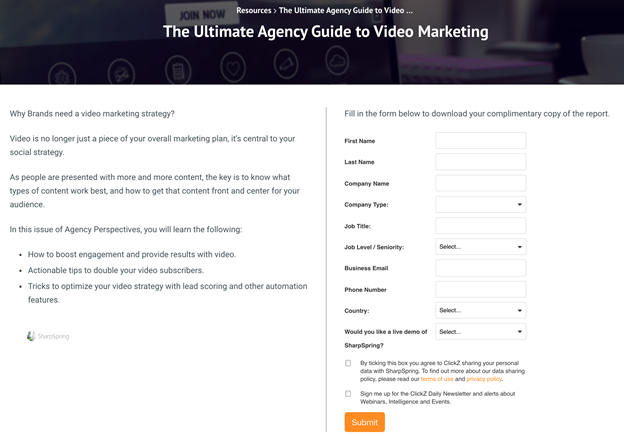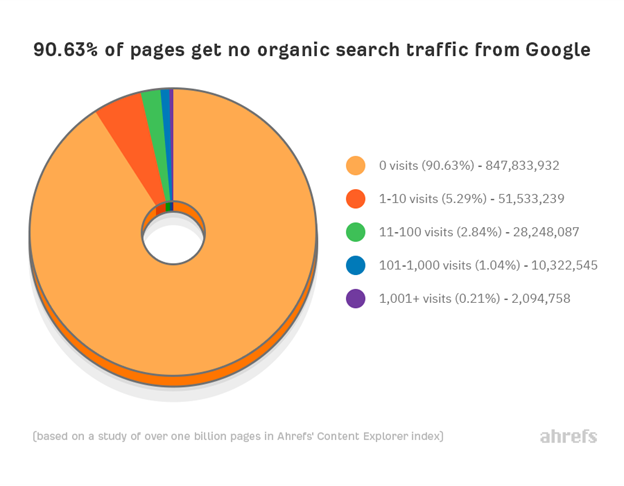30-second summary:
- Many businesses opt for content marketing because organic traffic is free. But, this strategy makes them miss a great opportunity to grow fast because combining SEO-optimized content with PPC speeds up the lead generation process.
- Online businesses need to know specific use cases for content marketing and PPC to assess the value of the strategy.
- Less than half of small businesses (45%) invest in PPC.
- PPC and SEO content marketing can bring in more leads by capturing more quality traffic with more effective keyword optimization of blog content, lead magnets, and landing pages.
- To get the most value from content marketing and PPC, businesses need to master keyword research, searcher intent, and the consistency between the landing page and ad optimization.
As someone who primarily engaged in SEO and content writing for small businesses, I didn’t really care about PPC advertising.
Maybe because of people like me, only 45% of small businesses invest in PPC.
I thought that the best way to bring high-quality leads was with super optimized content, so paid advertising was the realm of bigger companies. That’s the mindset of many small business owners. With teeny tiny marketing budgets, they have to choose between SEO/content and PPC.
SEO/content often becomes their choice, especially of those with interest in content creation and a lack of real marketing experience.
SEO was my preferred choice, too, and I saw PPC as something secondary.
Boy, was I wrong about this!
After a couple of projects involving PPC promotion, my view of the strategy completely changed. No, they didn’t change how I thought about SEO, but they showed how amazing the results could be if you combine the power of both strategies.
To all SEO specialists still not using PPC and the other way around, here’s what you’re missing.
1. More effective content thanks to PPC-tested keywords
Developing a content strategy is one of the most complex and important tasks for any SEO specialist. They use keyword research tools, PPC tools, Google Search Console results, and other methods to find those precious keywords used by customers.
When they find the keywords they think are good for targeting SEO/content marketing, they begin a slow process of creating content. I wrote oh-so-many blog articles, eBooks, checklists, reports, and other content to find out the keywords that attracted the most conversions.
All of this takes a lot of time.
In fact, to write a super effective blog post, you need more than six hours.
 Source: OrbitMedia
Source: OrbitMedia
When you’re done with writing the draft, there’s also proofreading, editing, making visuals, and keyword optimization. To cut a long story short, you might need a few days to complete a good article that can bring quality organic traffic.
But that’s not the end of that road.
Google, too, needs some time to index the article and rank it. In fact, it might take between two and six months to rank in the top 10.
That’s a bit much, agree?
To top it all off, the keywords you’ve chosen for your content might not the best ones to target. If you make this mistake, you’ll have to learn your mistakes and start all over again (welcome to the world of SEO content writing, folks).
Is there a way to speed this time-consuming process up? Yes. It’s PPC.
It can get you in front of the audience and allow you to test your keyword ideas much faster. If you have content to test, use PPC ads, and equip them with the keywords.
Get them out there and see what people respond to best. You can have some great results as early as a few days, which is pretty much impossible with SEO/content marketing.
Another great news is that you can run A/B testing. This means running ads featuring different keywords for the same content piece. If one performs much better than the other, update the content with the more popular keywords.
So, the takeaway here is that running PPC campaigns for content is a much faster way to test keywords. Start by finding keywords with research tools and make some ads, and you’ll be more likely to discover how your customers look for businesses like yours.
Related:
- Keyword Research Tools for Content Marketing
- 10 useful tools for writing compelling content for SEO
2. More leads from lead magnets
In content SEO, we often create lead magnets.
They are content pieces like reports, white papers, eBooks, webinars, videos, and other valuable content that people need to sign up to access.
You’ve seen tons of them before. A common example is a banner promoting an industry report with an irresistible CTA on a blog. It says that you need to provide your email address and name to access it instantly.
Click on that CTA, and you’ll go to a landing page with the lead capture form.
Like this “The Ultimate Agency Guide to Video Marketing” landing page, where everyone can download a guide with helpful tips on video marketing.

As you can see, the content is offered in exchange for some data. Not a bad deal of a guide packed with useful instructions for businesses.
Unsurprisingly, many content producers often turn to lead magnets for quick lead generation.
Ozan Gobert, a senior content writer at Best Writers Online said,
“Lead magnets work well for both B2B and B2C businesses aslong as they have some value for customers. You can generate some high-quality leads with them, as they typically attract those interested in insights and tips inside.”
If a blog has thousands of visitors every week, then there might not be a need for PPC promoting lead magnets. But is that true for your blog?
Many people think they can manage without the ads (I was one of them). Basically, it’s because they think that great content will “sell” itself.
Despite what they might think, not so many blogs are that successful in attracting visitors. In fact, more than 90% of web pages don’t get any organic search traffic from Google.

As you can see, only about 1.3 percent of web pages out there get decent traffic. Just for that tiny share, promoting a lead magnet with PPC advertising might not be necessary every time.
Obviously, the situation is very different for the rest.
If your website doesn’t have a lot of visitors, too, then creating lead magnets might be pointless. They’ll just sit there only to be discovered by a few people per week.
Not good because you need more leads.
If you wish that there was a way to get more people to pay attention to, there is actually a way.
And it’s PPC, of course. To get some emails, you need a well-crafted PPC campaign that leads people to the landing page where they can sign up to receive the content.
You can try to bring people with keyword-based ads promoting the lead magnet. If you choose the right keywords, the ads have a much greater chance to attract leads than SEO alone.
This is how it works: PPC does the job bringing in visitors, the content converts them into leads by having them complete the capture form.
To increase the chance of people signing up, the value of content is critical. But, the visual appeal is also a major consideration. You need tools for creating visual content like images, graphics, and infographics to add to your lead magnets.
3. Better marketing campaign performance thanks to a smart keyword use
Many businesses out there don’t realize they can bring much more quality traffic to their websites if they focus on best-performing keywords in both SEO, content marketing and PPC.
Much more traffic.
When an SEO/content marketing specialist and a PPC marketer share a list of relevant keywords, they can decide how to divide them to:
- Target the most promising keywords together to bring the most traffic
- Identify the keywords that are the most difficult for SEO and target them with PPC and the other way around
- Define which search queries to focus on with each lead acquisition strategy
Ultimately, the cooperation between the PPC and SEO teams can result in a much more effective keyword strategy. In turn, this strategy could attract more traffic to your websites.
Important note
To make content keyword optimization work, you need to master searcher intent or purchase intent. Put simply, searcher intent is the reason behind a search query.
For example, the query “Samsung a10 review” implies that the searcher is looking to do some research but has not made the decision yet. If they search Google for “buy Samsung a10 cheap”, then they might be ready to buy.
Each intent defines how you should create content. It matters a lot for SEO because Google’s goal is to provide its users with the most relevant results.
Dive Deeper: Tapping into Google’s Algorithm for Searcher Intent.
4. Create landing pages that convert more visitors
A landing page is the heart of any PPC marketing.
But, in many cases, PPC specialists aren’t the best persons to write the copy for it. By engaging content and SEO specialists and having them work with PPC folks, you can create a keyword optimized copy that also appeals to the readers.
For example, PPC specialists can provide keywords and ideas for optimized headings and subheadings for attracting traffic. In turn, content writers contribute by creating a copy that’s easy to read and entices the visitors to act.
So, the collaboration of PPC and SEO/content teams can result in campaign landing pages that generate clicks and converts.
A good way to start doing PPC campaign landing pages is to create a checklist to cover all bases. This checklist can include images, copy, sign up options, etc.
Know more: Studying the anatomy of a successful high-conversion landing page
SEO and PPC: Two are better than one
I’m not exaggerating when I say that SEO and PPC are a marriage made in heaven. I am positive that these points described in this article prove that.
Don’t make a mistake I made by neglecting the power of PPC advertising. Combined with SEO and quality content, you can greatly increase the quality of your traffic.
If you’d like to try them together, feel free to start by doing PPC ads for your best-performing blog articles. The results you’ll see will definitely impress and inspire you to try more. Thanks to this article, you’ll know your next steps.
Ana Mayer is a project manager with 3+ years of experience. She likes to read and create expert academic materials for the Online Writers Rating writing review website.
The post Tips and tools to combine content marketing and PPC appeared first on Search Engine Watch.

